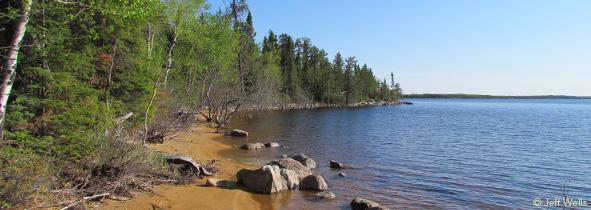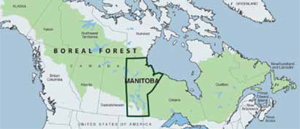Provincial and Territorial Forest Facts
Explore Canada's Boreal Forest by Province and Territory to see what makes each part of the boreal forest special.
Choose a province or territory:


Manitoba's Boreal Forest:
- is 570,000 km2 (141 million acres) in size – larger than France.1
- comprises 10% of Canada's Boreal Forest.
- is home to 49 aboriginal communities.2
- stores 19 billion tonnes of carbon in its soils, peat and forests – equivalent to nearly 100 years' worth of Canada’s GHG emissions in CO2 equivalent at 2014 levels.3
- contains Lake Winnipeg, the 14th-largest lake in the world (approximately 24,000 km2).
- contains the Seal River basin, one of Canada's wildest basins which supports robust populations of Arctic grayling, Northern pike and Lake trout, as well as Harbor seals and Beluga whales within its lower reaches and estuaries.4
- is the breeding grounds for 100 to 300 million birds of over 250 species, including threatened species like Yellow Rail, Canada Warbler and Olive-sided Flycatcher.
- is home to the Great Gray Owl, Manitoba's provincial bird, and the White Spruce, Manitoba's provincial tree.
- supports approximately 2,500, or 7%, of Canada's threatened boreal Woodland caribou population and supports over 700,000 Barren ground caribou within two herds that overlap with Northwest Territories, Alberta and Saskatchewan.5,6
- supports approximately 4,000 gray wolves.7
- features 467,000 km2 (115 million acres) of intact forest, peatland and wetland habitat free from industrial development, making up nearly 80% of the province's boreal region.8
CO2
1Canadian Boreal Initiative. 2003. Canada's Boreal Region.
2Aboriginal Canada Portal (www.aboriginalcanada.gc.ca), and Global Forest Watch.
3Tarnocai, C. and Lacelle, B. 1996. Soil Organic Carbon Digital Database of Canada. Eastern Cereal and Oilseed Research Center, Research Branch, Agriculture and Agri-Food Canada, Ottawa, Canada.
4Benke, A., and Cushing, C. Rivers of North America. 2005.
5Environment Canada. 2008. Scientific Review for the Identification of Critical Habitat for Woodland Caribou (Rangifer tarandus caribou), Boreal Population, in Canada. August 2008.
6The CircumArtic Rangifer Monitoring & Assessment Network. Accessed August, 2009. www.carmanetwork.com
7International Wolf Center. Accessed August, 2009. www.wolf.org
8Global Forest Watch Canada. 2009. Canada's Forest Landscape Fragments: A Second Approximation.

